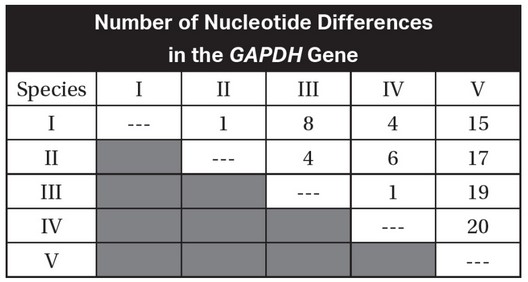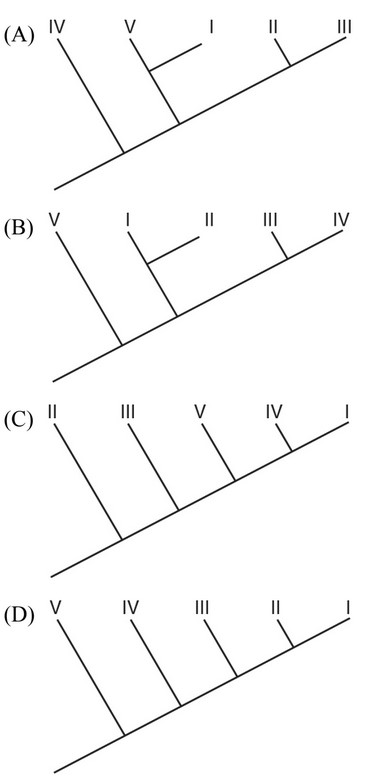Question
Which of the following pieces of evidence best supports the hypothesis that birds are more closely related to reptiles than to other animals?
(A) Fossils of birds and reptiles are first seen in rock layers from the
same time period.
(B) Birds and reptiles live in similar habitats and occupy the same
trophic levels.
(C) Both birds and reptiles are the only animals with amniotic eggs.
(D) Molecular studies show that the DNA from birds has a greater
degree of homology with the DNA from reptiles than with the
DNA from other animals.
▶️Answer/Explanation
Ans:
(D) DNA evidence strongly supports a degree of ancestry of
organisms. The location of fossils in rock layers can change due to
geological events, so choice (A) is not the best answer. Choice (B) is
incorrect because habitats and trophic levels do not necessarily indicate
common ancestry. Mammals also have amniotic eggs, so choice (C) is
incorrect.
Question
Generally, which type of data is considered most reliable when constructing phylogenies?
(A) fossil evidence, because it shows when species originated
(B) biogeography, because it shows organisms’ habitats
(C) morphological characteristics, because they show body structures
(D) molecular evidence, because it is less prone to convergent
evolution or changes caused by geological events
▶️Answer/Explanation
Ans:
(D) The DNA sequence of an organism is not affected by its
environment or geological events, so it provides reliable evidence for
ancestry of organisms. Fossils do not necessarily show when a species
originated, so choice (A) is incorrect. Habitats and morphological
characteristics can change during an organism’s lifetime, so choices (B)
and (C) are incorrect.
Question
Five new bacterial species were discovered in the Mariana Trench in the Pacific Ocean. The glyceraldehyde 3-phosphate dehydrogenase (GAPDH) gene was sequenced in all five species, and the number of nucleotide differences in the GAPDH gene among the five species is shown in the table.
Which of the following cladograms is best supported by the data in the table?
▶️Answer/Explanation
Ans:
(B) Species V is the outgroup because it has the greatest number of
amino acid differences from the other species. Species I and II have
only one amino acid difference between them and are therefore closely
related. Species III and IV have only one amino acid difference
between them and are therefore closely related. Choice (A) is incorrect
because species I is more closely related to species II (one amino acid
difference) than species V (15 amino acid differences). Species II has
fewer amino acid differences from the other species than does species
V, so species II is not the outgroup. Thus, choice (C) is incorrect.
Choice (D) is incorrect because species I has only four amino acid
differences from species IV but eight amino acid differences from species III, so species IV should share a more recent common ancestor
with species I.
Question
Five new bacterial species were discovered in the Mariana Trench in the Pacific Ocean. The glyceraldehyde 3-phosphate dehydrogenase (GAPDH) gene was sequenced in all five species, and the number of nucleotide differences in the GAPDH gene among the five species is shown in the table.
Based on the data in the table, which species is the outgroup?
(A) II
(B) III
(C) IV
(D) V
▶️Answer/Explanation
Ans:
(D) Species V is the outgroup because it has the greatest number of
amino acid differences from the other four species.
Question
Which of the following best supports the existence of a common ancestor of all three domains of living organisms (Archaea, Bacteria, and Eukarya)?
(A) All living organisms perform glycolysis in their cytoplasm.
(B) All living organisms have membrane-bound organelles.
(C) All living organisms have linear chromosomes.
(D) All living organisms have genes that contain introns.
▶️Answer/Explanation
Ans:
(A) All living organisms perform glycolysis in their cytoplasm,
indicating a common ancestor of all life-forms. Choice (B) is incorrect
because not all living organisms have membrane-bound organelles.
Prokaryotes do not have linear chromosomes or introns, so choices (C)
and (D) are incorrect.
